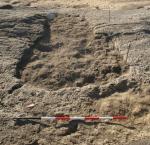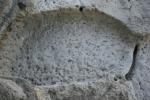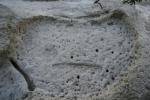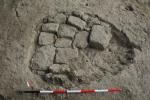Summary (English)
Excavations during the 39th campaign took place in sector Vb and opened a new sector, XII.
Sector Vb, situated at the base of the south cliff face, is a long “ditch” house (4 m wide, 2 m, deep), so far over 30 m has been uncovered, but which certainly extends beyond the eastern trench edge. Only a section of a few metres had been excavated, but it was enough to show the structure’s residential function and that the ditch was intentionally filled as early as the Final Bronze Age.This year a surface with traces of burning was identified below layers of collapse in which there was no medieval pottery and only a few fragments of Etruscan pottery. Downhill from this sector, there was a cut in the terrace bedrock along which was a concentration of tufa stones that certainly did not come from this area. It is probable that this was the continuation of the large “ditch” house and that the stones represented the collapse of a dry-stone structure within it or the remains of the layer sealing the ditch fill, identified by the old excavations.
Sector XII, in the eastern part of spur was occupied by several structures, the largest of which was a dwelling with two rock-cut rooms, similar to those found in sector Ve.
This season, once the layers filling the structures had been excavation, the recording of the hut was completed and the excavation area was extended towards the east and west in order to check for the presence of other dwellings or service structures, similar to those documented in sector I.The results were very interesting: in fact, a circular structure came to light in the extension to the west, cut into the rock to a depth of a few centimetres, sealed by squared stone blocks with a small channel at the centre of its downhill side that probably drained water from its interior. The structure was certainly proto-historic in date, as attested by patches of a layer containing impasto pottery and traces of working left in the rock. At present the structure’s function is unknown .
The extension towards the east also revealed an interesting structure at a short distance from the hut, formed by a small quadrangular room and an access corridor. Its excavation remains to be completed and only the latest dumps of material were removed. It appears too small to be a dwelling, although it is similar in plan. It could be a service structure. The continuation of the excavations should clarify its function.
- Nuccia Negroni Catacchio - Università degli Studi di Milano, Dipartimento di Scienze dell’Antichità e Centro Studi di Preistoria e Archeologia
Director
- Nuccia Negroni Catacchio - già Università degli studi di Milano, Politecnico di Milano, Centro Studi di Preistoria e Archeologia, Milano
Team
- Carlotta Finotti - Centro Studi di Preistoria e Archeologia
- Marco Romeo Pitone - Centro Studi di Preistoria e Archeologia
- Massimo Cardosa - Accademia di Belle Arti di Brera e Centro Studi di Preistoria e Archeologia
Research Body
- Università degli Studi di Milano
- Università degli Studi di Siena, Dipartimento di Archeologia e Storia delle Arti, Sezione di Preistoria
Funding Body
- Fondazione Carivit
- Provincia di Viterbo






![Download [PDF]](/excavation/skins/fasti/images/results/download_sml.png)


